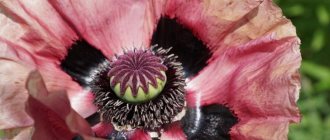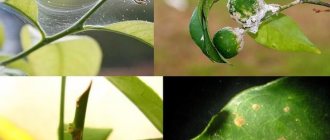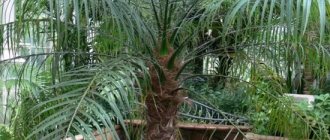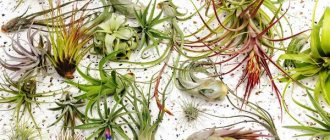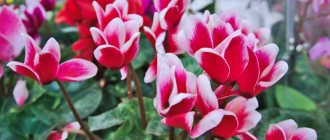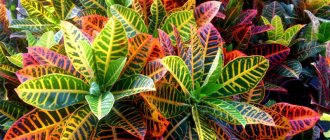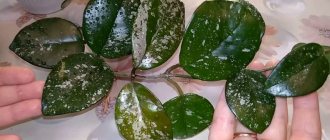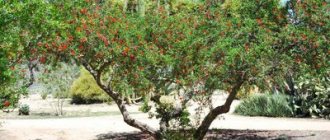Nolina (lat. Nolina) is a perennial plant native to the tropical forests of South America. Belongs to the Asparagaceae .
Nolina has a very unusual appearance, which is why it even received the popular names “elephant’s foot” and “bottle tree” . The trunk at the base expands fancifully. This part of the plant is called the caudex. This is where moisture accumulates “in reserve.” Further, the trunk sharply narrows and forms a branch at the top, covered with long and narrow leaves.
In their natural habitat, some species can reach 10 m in height, but indoor plants are rarely taller than 1.5 m .
Nolina is not very popular as a houseplant, but this is not explained by the difficulty of caring for it, but rather by its exoticism . Meanwhile, this is a very useful plant. Growing nolina at home has a beneficial effect on the composition of the air. It releases phytoncides in the form of an aerosol, which effectively eliminate bacteria and viruses.
Nolina care
Nolina, bocarnea, ponytail, bottle tree - these are the names of one exotic plant. The flower belongs to the succulent family Agave. The description of nolina first appeared in 1803 thanks to the Frenchman Andre Michaud. The popularity of the flower is explained not only by its decorative appearance, but also by its exceptional unpretentiousness.
Nolina's homeland and appearance
The plant is native to Texas and northern Mexico. Nolina is perfectly adapted to survive in areas with very hot climates. A few rains are enough for the plant to accumulate a sufficient amount of moisture in the trunk. In hot weather, leaves gather in bunches and, thus, the evaporation of water from their surface is significantly reduced.
Nolina rightfully belongs to the most ornamental plants. The trunk is thick, greatly expanding towards the bottom. As a result, the shape of the barrel resembles a bottle.
The leaves are concentrated in the upper part of the plant, collected in bunches. The leaf blades are dense, leathery, fleshy, dark green in color. The length of each sheet can reach one meter.
Under natural conditions, the tree can reach a height of eight meters. As for flowering, it is impossible to see flowers in indoor conditions, since nolina can only bloom in natural conditions.
Nolina or bocarnea belongs to unpretentious plants. Considering the structural features of the trunk and the ability to accumulate water in it, nolina can not be watered for a long time. What the plant cannot tolerate is excess moisture. Excess water that gets into the soil does not evaporate, as a result the plant rots and dies.
It should be remembered that nolina grows slowly. It happens that for a long time the gardener does not notice any signs of plant growth, however, one should be patient. In order to speed up the growth process, it is enough to follow the recommendations of experts.
Watering mode
Compliance with the watering regime is an important condition for the successful cultivation of nolina. In spring and summer, the plant needs abundant but infrequent watering. As a rule, the bottom watering method is used, when the flower pot is placed in a container of water. You can remove the flowerpot when the top layer of the substrate becomes shiny. After this, you need to wait for the excess moisture to drain and put the flowerpot in its usual place. The next watering can be done only after the soil is completely dry.
In autumn and winter, if there is no dormant period, the watering regime does not change; you can periodically spray the plant, preventing water from getting on the trunk.
At temperatures from +15 to +10 degrees, watering is reduced, and at lower temperatures it stops.
An adult plant can easily survive without watering for a year, using the water that has accumulated in the trunk.
Lighting requirements
Considering that in natural conditions nolina grows in bright light, it also needs to find the brightest place in the room. It is best to place the flowerpot on a south window. Otherwise, the plant trunk will bend, trying to reach the sun.
Temperature
In summer, the optimal temperature for nolina is from +20 to +25 degrees, and in autumn and winter the plant needs a dormant period. At this time, the temperature is reduced to +10 degrees.
In summer, in warm weather, you can take the plant out into the fresh air, but reliably protect it from drafts.
Top dressing
During the period of active growth, that is, in spring and summer, nolina is fed once every three weeks. It is best to alternate mineral and organic fertilizers, and it is important to reduce the concentration of fertilizers by half compared to what is indicated on the package.
Nolina tolerates cactus fertilizers, manure and mullein well. During the replanting process, you can add ash to the soil.
Origin and characteristics of bocarnea
Where did this natural miracle come from in our apartments?
Even an ultra-fashionable phytodesigner would not think of bringing to life such forms as the nature of Mexico did by creating nolina. By the way, in its homeland this plant, known to people for more than a century, reaches 10 meters and blooms in white fragrant clusters, and its rather hard leaves are used for weaving hats and baskets. Of course, in indoor conditions you will not see such a giant - the maximum that can be achieved is 90 centimeters in diameter and 2 meters in height, provided that you can provide suitable care throughout the 6-7 years of the plant’s life. An adult indoor nolina is an outdoor plant. The unpretentious bocarnea nolina adapts to different temperatures and does not suffer from proximity to heating radiators, but does not like drafts. In addition, three varieties of “bottle tree” are found in indoor culture.
Nolina transplant
When planning to replant nolina, it is important to consider that the root system is located close to the soil surface, so you need to choose a wide and shallow pot. The diameter of the new flowerpot should be 3 cm larger than the previous one.
The optimal period for replanting the plant is annually in the spring. An adult nolina is replanted once every three years. When the plant slows down its growth and roots appear from the drainage holes, this is the first sign that it is time to prepare a new pot and substrate.
During the replanting process, you must constantly ensure that the thick part of the trunk remains above the soil surface. Only the root system needs to be buried in the substrate. In this case, the roots need to be spread throughout the entire volume of the flowerpot.
The substrate required has the following composition:
- Leaf soil - one part;
- Peat land - one part;
- Sand - two parts.
To increase nutritional value, one part of humus is added to the soil. The plant develops quickly if two parts of turf soil are added to the soil. You can also choose a ready-made substrate for cacti in a specialized store.
When replanting, it is necessary to provide a drainage layer to eliminate the possibility of water stagnation.
After transplantation, the plant cannot be watered for several days, then you can switch to the normal watering regime. If the plant had to be replanted due to illness, the dry period should be extended by ten days.
What and when to feed bocarna
In principle, bocarney is indifferent to fertilizing, but to maintain health and decorativeness during the active growing season, fertilizers are applied once a month. Special products for cacti and succulents with a low nitrogen content are suitable. The concentration of the drug is halved compared to the manufacturer's recommendations. You can feed bocarna and organic matter, alternating it with mineral fertilizers. In this case, a very weak solution is prepared: fresh cow manure is infused for 3-4 days, then it is diluted with water 1:20.
Excess nitrogen can cause leaf hardness to decrease. Their decorative effect is also lost.
Special fertilizers for cacti and succulents are quite suitable for Bokarna.
Reproduction of nolina
The easiest way to grow a new plant at home is to buy nolina in a specialty store. All methods of plant propagation are troublesome and require serious time investment.
Propagation by seeds
After purchasing planting material, you must first select defective seeds. This can be done as follows: soak all the seeds for a day, and throw away those that end up on the surface.
For planting, you need to prepare wide, shallow bowls, fill them with a damp substrate, mixing sand and peat in equal proportions.
It is enough to place the seeds on the substrate, lightly press them down with your hands and cover them with glass on top. After this, the bowl should stand in a bright, warm place. Such conditions are most comfortable for seed germination. If there is not enough light, an additional light source is used. The duration of daylight for nolina seeds is at least 12 hours. It is necessary to regularly ventilate the bowl and maintain a comfortable level of humidity. Under such conditions, seed germination takes two to three weeks.
The glass can only be removed after the first few leaves have appeared. The watering regime should be as follows: it is better to dry the plant a little than to over-moisten the soil.
When the plants become stronger, they can be planted in a permanent growing location.
You cannot remove the seed shell yourself, since the young plant feeds on the reserves contained in the seeds. When the plant is strong enough, the seed coat will fall off on its own.
Propagation by lateral cuttings
This method is complicated because side shoots appear quite rarely on the plant. If a shoot appears, it can be carefully cut off and rooted.
The cuttings are cut as close to the base of the stem as possible, and the cut site is treated with crushed activated carbon. The cuttings are dried for five hours. It is better to trim the bottom row of leaves; you can leave only a few top leaves.
The substrate for planting should be light; soil for seeds can be used. The substrate around the cutting needs to be crushed a little, cover the plant with film or glass and place the pot in a warm and bright place. Until the cuttings are completely rooted, it is important to monitor the level of soil moisture and regularly ventilate the room. When young leaves appear, the shelter can be removed.
Kinds
Both in its natural environment and as a houseplant, nolina has the appearance of a palm tree. Long, from 30 cm to 1 m, thin linear leaves of green and dark green color grow from the upper part of the trunk.
The surface of the sheet is elastic, hard, with pronounced longitudinal grooves. New leaves always grow from the center of the “green tuft”.
In its natural environment, nolina is distributed throughout Mexico. Baskets, hats, and mats are woven from its leaves, which, due to their high strength, are highly wear-resistant.
All types of nolina have a strong surface structure of the trunk, gray or brown in color. The bark is rough and cracked. Under the roughened bark there is moist green pulp. The swollen part of the trunk is called the caudex, above which there is a narrower trunk. Sometimes there may be several trunks above the caudex, each of them ending in a tuft of green foliage.
Plant varieties differ in the shape and height of the trunk, the length and color of the leaves. Some species can be miniature in size, while others can be as tall as a bus.
Nolina recurvata
Another name for nolina recurvata. Homeland - Southern and Western border of the United States. In the natural environment it grows up to 6 - 8 m, at home no higher than 2 m. The trunk is bottle-shaped, in some cases it can branch. In its natural environment, nolina reflexum can grow up to 1 m in diameter. The leaves are dark green, hard, hanging, ribbon-shaped, growing up to 1 m in length and up to 2 cm in width. They sprout from the top of the trunk. At home, Nolina recurta does not bloom. In nature, an adult tree blooms with small pink fragrant flowers in a paniculate inflorescence.
Nolina recurvata / Nolina recurvata
Nolina lindheimeriana Nolina lindheimeriana
A distinctive feature is that a rather narrow long trunk branches off from a wide base. The leaves are dark green, long, narrow, growing from a dense bunch at the top of the trunk. They grow very densely, forming a lush crown. At home it can grow up to 1.5 m.
Nolina longifolia
In its natural environment it can be found in Mexico. An adult tree has a wide trunk with many branches and pronounced cracks. The leaves are dark green, hard, hanging, long, ribbon-like, pointed downwards. In its natural environment, nolina longifolia can grow up to 2 - 3 m in height.
Nolina matapensis Nolina matapensis
In nature, the height of the tree is no more than 2 m. The leaves from the bunch at the top of the trunk dry out, starting from the bottom ones. Over time, they fall off and lie below, along the trunk, forming a kind of “skirt”. This species is not grown at home. Bocarney flowers are pale yellow, collected in paniculate inflorescences.
Shaping the trunk
The decorativeness of the trunk and the appearance of the plant depend on the conditions of maintenance.
If you frequently water the nolina and place the flowerpot in a room with average lighting, the trunk will stretch out, the thickening will disappear or remain insignificant. But the crown will be thick and lush.
In order to grow an ornamental plant shaped like a bottle, it is better to place the flowerpot in a well-lit place and water it rarely but abundantly. The trunk will increase in size gradually, accumulating moisture.
Description
The tropical regions of Central and South America are considered the homeland of Pachira. In our country, Pachira is classified as a member of the Bombax family (baobabaceae), and in the taxonomy of England it is classified as a member of the Malvaceae family. The leaf blades of the plant resemble chestnut leaves, for which the tree is sometimes called the giant chestnut of Guiana or the Malabar chestnut. Translated from Latin, Pachira means plump - the appearance of the trunk often corresponds to this name. There are other names for this unusual tree. Chinese tree and bottle tree. And in East Asia and Japan, Pachira is called the money tree. It is grown in many enterprises, farms, and private estates, since it is believed that it contributes to the accumulation of capital. The Taiwanese economy exports many millions of dollars worth of bottlewood to different countries around the world every year.
Pakhira according to feng shui
Feng Shui masters believe that Pachira brings health, luck and material well-being to the home. Each of the five fingers on the Pachira leaf symbolizes its own natural element - metal, water, fire, earth and wood. The formation of another leaf helps to increase family wealth. Growing this wonderful tree in your home will contribute to the formation of a special aura that enhances the effect of positive and weakens the effect of negative energies formed on the principles of Feng Shui.
Note to the florist
Why do nolina leaves dry out?
- The tips of the leaves dry out. The problem occurs if the plant is kept in a room with dry air. In such a situation, it is enough to spray the flower, but avoid getting water on the trunk. Otherwise, dark spots appear on the trunk and it rots. It can also be caused by insufficient watering or lack of nutrients in the soil.
- The leaves are withering. The reason lies in insufficient lighting. In summer, you need to choose the brightest window in the house, and in winter, use an additional source of lighting.
- The lower leaves dry out. This process is natural and should not cause concern.
- The trunk of the plant dries up. This occurs due to loss of moisture after wintering. The plant's normal appearance will be restored immediately after the normal watering regime is resumed.
Why is nolina growing slowly?
- Few new leaves are formed. The reason is lack of nutrients. Feeding the flower or replanting will help solve the problem.
- New leaves are small. This happens if nolina grows in a cramped pot, lacks lighting and is exposed to high temperature.
How to replant a bottle tree?
Firstly, not all types of flower pots are suitable for nolina. You need to pay more attention to this issue, choose a wide and low container with a mandatory drainage hole. The width and height should have an approximate ratio of 1:3, since a third of the volume is filled with drainage before planting the plant.
Bocarnea, purchased in a low-quality flower pot, needs to be replanted. To do this, it is advisable to remove the plant from the old container along with a lump of earth, so as not to cause additional stress to the tree during adaptation to the new habitat, and then carefully plant it. The first few days will be the most stressful period, so you should keep the plant in the shade during this period and not water it. Even if the top layer of soil dries out, it will not harm the crop.
If the earthen ball surrounding the root system of the plant is too wet, this indicates improper care of the nolina in the store. In this case, it would be correct to let the soil air dry a little without planting the young tree in a new pot for several hours.
In the future, the crop needs to be replanted every spring as it develops and grows. Over the years, the interval between transplants will increase until, after the plant reaches 15 years of age, this procedure will seem impossible due to the enormous size of the tree.
Each year the annual transplant should be done as follows:
- The selected container of suitable volume is filled 1/3 with drainage, followed by a small layer of soil selected for growing nolina.
- After this, the plant is pulled out of the old pot, the root system is cleared of soil and inspected for signs of rot. If it is detected, damaged areas must be immediately removed with a sharp sterile blade, and the cut areas must be sprinkled with charcoal.
- As soon as the tree is ready for planting, it is placed in the center of the container, carefully straightening the root shoots and eliminating their bends as much as possible. The plant installed in a new place must be sprinkled with earth, compacting it well for reliable fixation. If the soil still cannot cope with this task, the crop can be supported by installing decorative stones or other heavy materials around the trunk.
When planting, it is necessary to ensure that the trunk does not go deep into the ground, otherwise this can lead to serious consequences for deteriorating the health of the bottle tree.
To create a decorative floral composition from different representatives of bokarnaia, it is advisable to use specimens of approximately the same age. If plants are planted at a minimum distance from each other, then over time, when they come into contact, they will grow into a single whole, representing a tree with a very interesting appearance. A distinctive decorative feature of the planting will be the presence of several tops on a powerful trunk, which can be formed at the same level or in a cascade.
Nolina care video
Nolina is a succulent plant with an unusual appearance and simple growing conditions.
The flower tolerates bright light and high temperatures well; in winter, a period of rest and a decrease in temperature to +10 degrees is required. Nolina leaf juice is the best remedy against insect pests. Particular attention should be paid to the watering regime - excess moisture should not be allowed and watering should be adjusted depending on the time of year and the conditions of the flower. You can also share your secrets for caring for nolina. If you have questions, ask them in the comments below, we will be happy to answer them.
Diseases and pests
The “bottle palm” has excellent immunity, protecting the plant from diseases and pests. However, it can also be affected by such a common parasite as the mealybug, also known as the hairy louse or pseudococcida. They can be removed with a napkin or swab soaked in alcohol.
In addition, thrips, scale insects or spider mites can be found on the flower, which appear on both sides of the foliage. As a result of infection, the leaves become deformed, they turn yellow and die.
The parasites are removed with a cloth soaked in soapy water, and then the affected areas are treated with insecticidal preparations, Karbafos or Actellik.
To avoid such troubles, it is recommended to carry out preventive treatments of the plant with fungicidal agents, as well as adhere to the rules of care and maintenance of this exotic flower.



